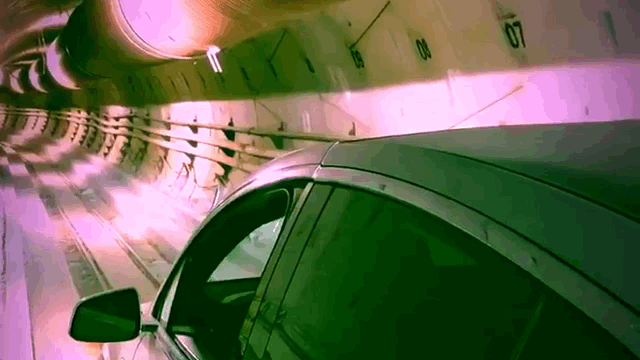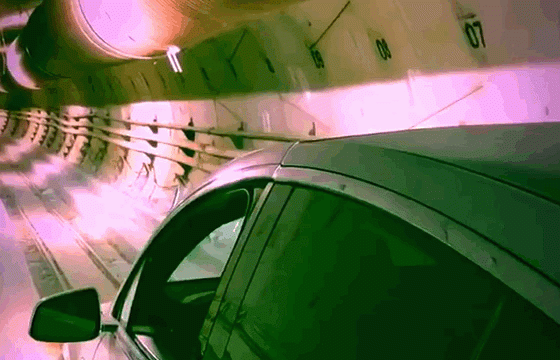

News
Elon Musk shares first look at Tesla Model X zipping through a Boring Company tunnel
After winning the coveted contract to build Chicago’s high-speed transit tunnel, the Boring Company held a press conference at the city’s Block 37 Superstation to formally announce the tunneling startup’s high-profile project. Dubbed by Mayor Rahm Emanuel as the “X,” the high-speed tunnel system is designed to link downtown Chicago to O’Hare Airport.
Prior to the press conference, The Boring Company shared a video of a Tesla Model X being carried by “electric skates” through a tunnel on Twitter. While incredibly brief, the short clip gives an idea of the speed that Chicago commuters can expect from the tunneling startup’s transportation system.
Tesla and SpaceX CEO Elon Musk made an appearance at Block 37 Superstation, sharing the stage with the city mayor. As noted by Chicago Tribune reporter Bill Ruthart on Twitter, Emanuel was very optimistic about the Boring Company’s project, stating that the high-speed tunnels would “not cost the city a penny” and that it builds on Chicago’s “legacy of innovation.” Emanuel noted that part of the reason behind the city’s decision to select the Boring Co. was Musk’s record and vision.
“We’re taking a bet on a guy who doesn’t like to fail — and his resources. There are a bunch of Teslas on the road. He put SpaceX together. He’s proven something. The risk — with no financial risk — is I’m betting on a guy who has proven in space, auto and now, a tunnel, that he can innovate and create something of the future,” the Chicago Mayor said.
Addressing Chicago’s press, Elon Musk expressed his thanks at the city and Mayor Emanuel for placing his faith in the Boring Co. Musk noted that he hopes to start digging in as soon as four months. Digging shall commence from both Loop and O’Hare ends. When asked about the high-speed tunnels’ funding, Musk noted that he is confident he can raise the estimated ~$1 billion for the project, considering that he has already raised $22 billion among all of his companies. The serial tech entrepreneur also noted that the downtown Chicago-O’Hare tunnel is “quite economically appealing.” Lastly, Musk announced that The Boring Company would tap both union and non-union workers for manpower.

The city of Chicago formally announces The Boring Company’s downtown-O’Hare tunneling project. [Credit: The Boring Company]
The Boring Company’s high-speed Chicago tunnel system is expected to accommodate almost 2,000 passengers per direction every hour, with pods leaving every 30 seconds to 2 minutes. Cost for the high-speed rail is estimated to be between $20-$25 per person, roughly half the price of a typical ride-share or cab. The trip is expected to last only 12 minutes with pods traveling more than 100 mph. The upcoming project’s preliminary route will be Block 37, Randolph St. west, under the Kennedy north, north under Halsted, northwest under Milwaukee, northwest under Elston before again crossing under the Kennedy near Bryn Mawr Avenue and heading west to O’Hare, according to people familiar with the matter.
The Boring Company and the Chicago mayor have noted that it is far too early to provide a concrete timeline for the completion of the high-speed tunnel system. Apart from handling the costs of the project, The Boring Company will also construct a new station at O’Hare and help in the completion of the Block 37 Superstation. Overall, the ~$1 billion tunnel is part of Chicago’s $8.5 billion overhaul of O’Hare Airport.
The Boring Company’s contract with Chicago stands as the tunneling startup’s first high-profile project. So far, the Boring Co. has only embarked on smaller-scale test projects in Los Angeles, as well as a tunnel beneath SpaceX in Hawthorne, CA, which will offer free demo rides to the public upon regulatory approval.

News
Tesla FSD fleet is nearing 7 billion total miles, including 2.5 billion city miles
As can be seen on Tesla’s official FSD webpage, vehicles equipped with the system have now navigated over 6.99 billion miles.

Tesla’s Full Self-Driving (Supervised) fleet is closing in on almost 7 billion total miles driven, as per data posted by the company on its official FSD webpage.
These figures hint at the massive scale of data fueling Tesla’s rapid FSD improvements, which have been quite notable as of late.
FSD mileage milestones
As can be seen on Tesla’s official FSD webpage, vehicles equipped with the system have now navigated over 6.99 billion miles. Tesla owner and avid FSD tester Whole Mars Catalog also shared a screenshot indicating that from the nearly 7 billion miles traveled by the FSD fleet, more than 2.5 billion miles were driven inside cities.
City miles are particularly valuable for complex urban scenarios like unprotected turns, pedestrian interactions, and traffic lights. This is also the difference-maker for FSD, as only complex solutions, such as Waymo’s self-driving taxis, operate similarly on inner-city streets. And even then, incidents such as the San Francisco blackouts have proven challenging for sensor-rich vehicles like Waymos.
Tesla’s data edge
Tesla has a number of advantages in the autonomous vehicle sector, one of which is the size of its fleet and the number of vehicles training FSD on real-world roads. Tesla’s nearly 7 billion FSD miles then allow the company to roll out updates that make its vehicles behave like they are being driven by experienced drivers, even if they are operating on their own.
So notable are Tesla’s improvements to FSD that NVIDIA Director of Robotics Jim Fan, after experiencing FSD v14, noted that the system is the first AI that passes what he described as a “Physical Turing Test.”
“Despite knowing exactly how robot learning works, I still find it magical watching the steering wheel turn by itself. First it feels surreal, next it becomes routine. Then, like the smartphone, taking it away actively hurts. This is how humanity gets rewired and glued to god-like technologies,” Fan wrote in a post on X.
News
Tesla starts showing how FSD will change lives in Europe
Local officials tested the system on narrow country roads and were impressed by FSD’s smooth, human-like driving, with some calling the service a game-changer for everyday life in areas that are far from urban centers.

Tesla has launched Europe’s first public shuttle service using Full Self-Driving (Supervised) in the rural Eifelkreis Bitburg-Prüm region of Germany, demonstrating how the technology can restore independence and mobility for people who struggle with limited transport options.
Local officials tested the system on narrow country roads and were impressed by FSD’s smooth, human-like driving, with some calling the service a game-changer for everyday life in areas that are far from urban centers.
Officials see real impact on rural residents
Arzfeld Mayor Johannes Kuhl and District Administrator Andreas Kruppert personally tested the Tesla shuttle service. This allowed them to see just how well FSD navigated winding lanes and rural roads confidently. Kruppert said, “Autonomous driving sounds like science fiction to many, but we simply see here that it works totally well in rural regions too.” Kuhl, for his part, also noted that FSD “feels like a very experienced driver.”
The pilot complements the area’s “Citizen Bus” program, which provides on-demand rides for elderly residents who can no longer drive themselves. Tesla Europe shared a video of a demonstration of the service, highlighting how FSD gives people their freedom back, even in places where public transport is not as prevalent.
What the Ministry for Economic Affairs and Transport says
Rhineland-Palatinate’s Minister Daniela Schmitt supported the project, praising the collaboration that made this “first of its kind in Europe” possible. As per the ministry, the rural rollout for the service shows FSD’s potential beyond major cities, and it delivers tangible benefits like grocery runs, doctor visits, and social connections for isolated residents.
“Reliable and flexible mobility is especially vital in rural areas. With the launch of a shuttle service using self-driving vehicles (FSD supervised) by Tesla in the Eifelkreis Bitburg-Prüm, an innovative pilot project is now getting underway that complements local community bus services. It is the first project of its kind in Europe.
“The result is a real gain for rural mobility: greater accessibility, more flexibility and tangible benefits for everyday life. A strong signal for innovation, cooperation and future-oriented mobility beyond urban centers,” the ministry wrote in a LinkedIn post.
News
Tesla China quietly posts Robotaxi-related job listing
Tesla China is currently seeking a Low Voltage Electrical Engineer to work on circuit board design for the company’s autonomous vehicles.

Tesla has posted a new job listing in Shanghai explicitly tied to its Robotaxi program, fueling speculation that the company is preparing to launch its dedicated autonomous ride-hailing service in China.
As noted in the listing, Tesla China is currently seeking a Low Voltage Electrical Engineer to work on circuit board design for the company’s autonomous vehicles.
Robotaxi-specific role
The listing, which was shared on social media platform X by industry watcher @tslaming, suggested that Tesla China is looking to fill the role urgently. The job listing itself specifically mentions that the person hired for the role will be working on the Low Voltage Hardware team, which would design the circuit boards that would serve as the nervous system of the Robotaxi.
Key tasks for the role, as indicated in the job listing, include collaboration with PCB layout, firmware, mechanical, program management, and validation teams, among other responsibilities. The role is based in Shanghai.
China Robotaxi launch
China represents a massive potential market for robotaxis, with its dense urban centers and supportive policies in select cities. Tesla has limited permission to roll out FSD in the country, though despite this, its vehicles have been hailed as among the best in the market when it comes to autonomous features. So far, at least, it appears that China supports Tesla’s FSD and Robotaxi rollout.
This was hinted at in November, when Tesla brought the Cybercab to the 8th China International Import Expo (CIIE) in Shanghai, marking the first time that the autonomous two-seater was brought to the Asia-Pacific region. The vehicle, despite not having a release date in China, received a significant amount of interest among the event’s attendees.








